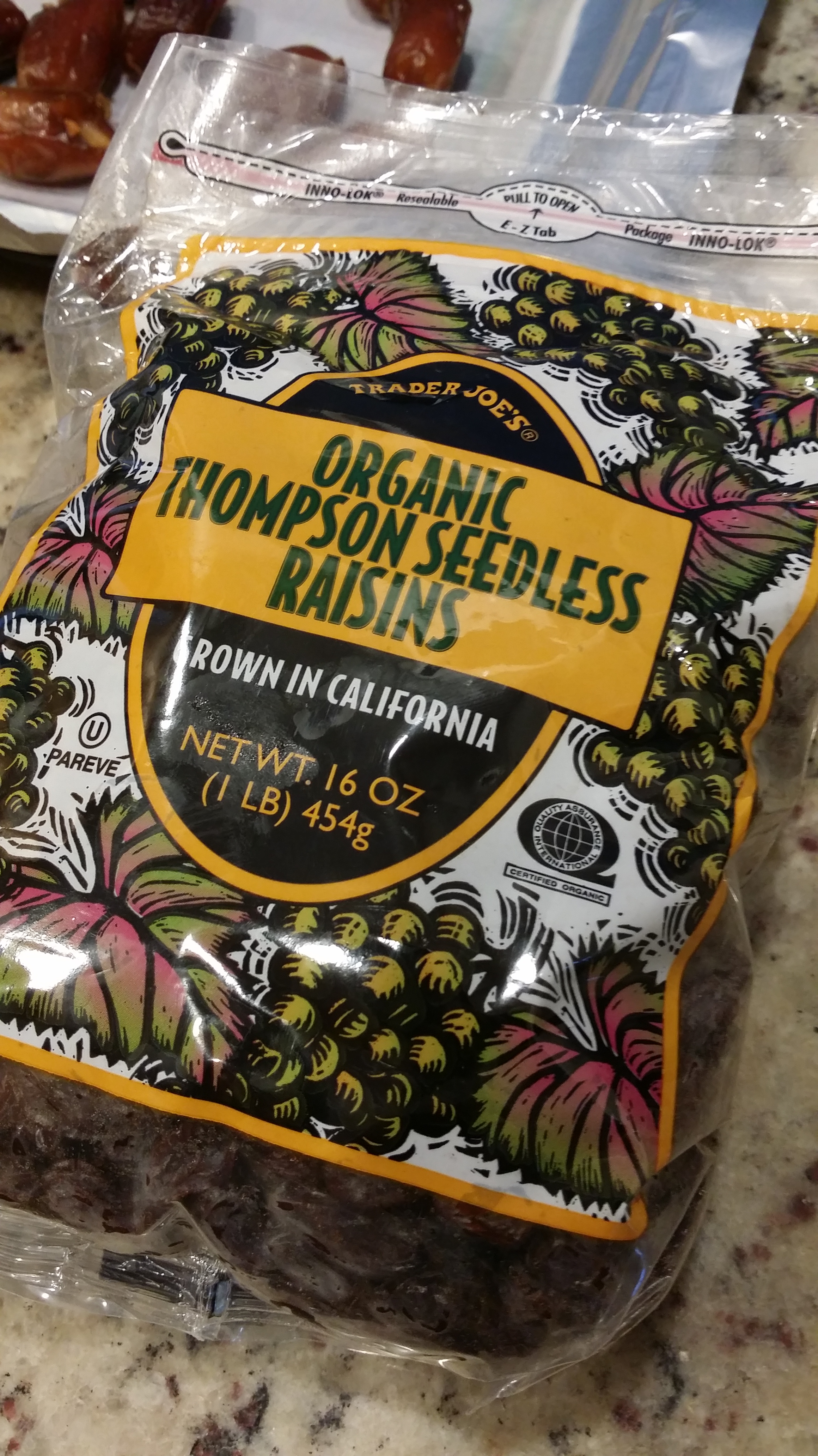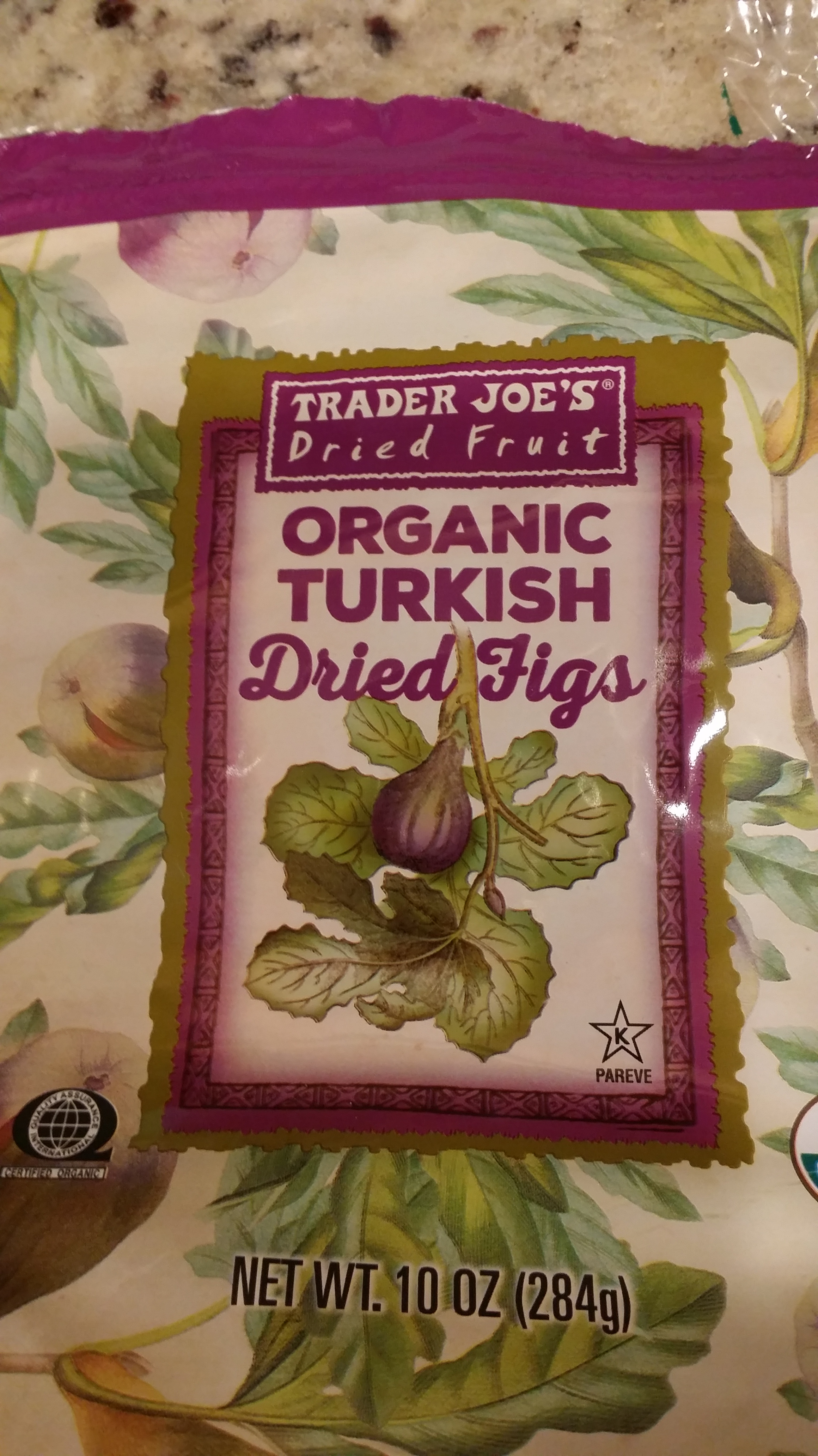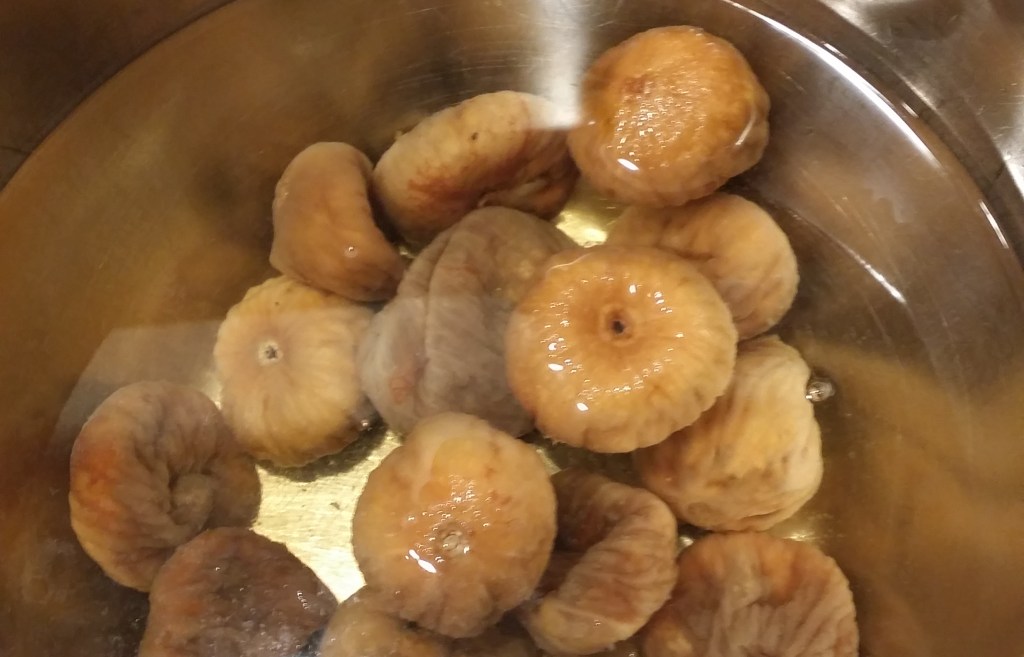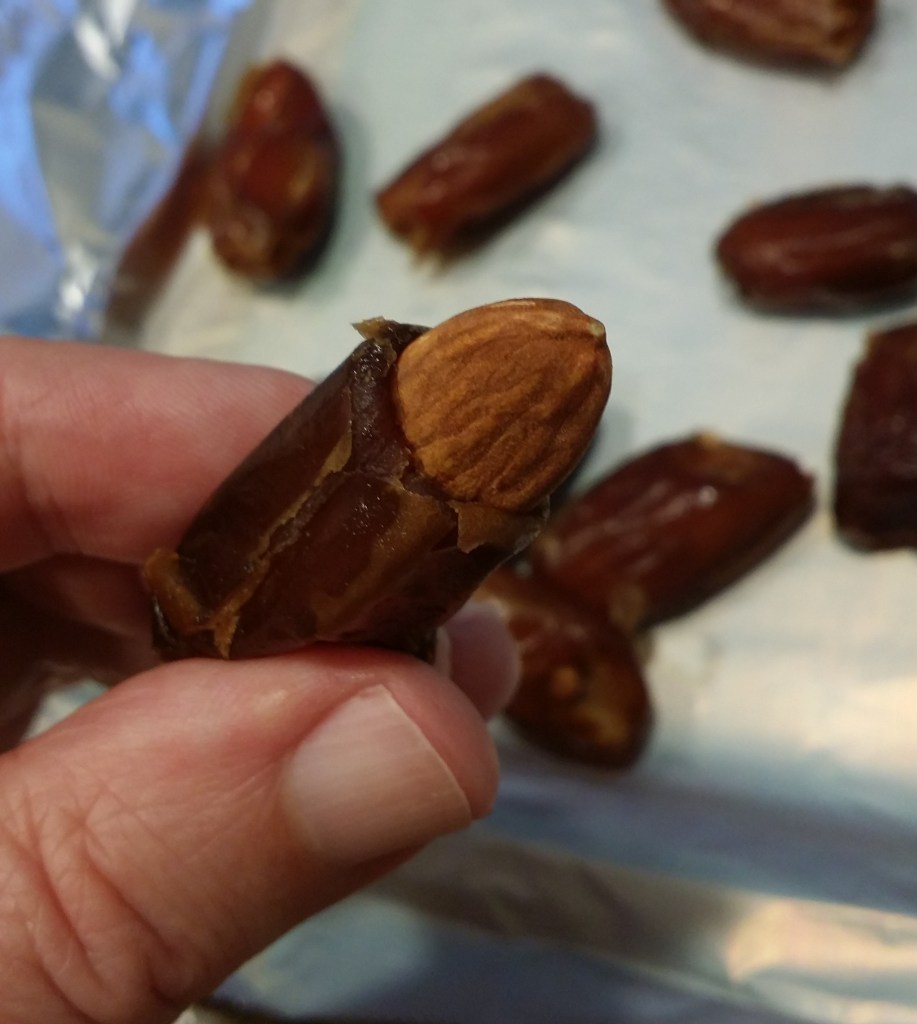I’m in Naples, Florida right now, enjoying the famous sunshine and supposedly having a well-earned rest. But I find it hard to completely switch off from my exploration of medieval food. And being as some folk in the condo community, here, wanted me to make something medieval to have with drinks at the pool, I succumbed to the pull of Richard II’s cookery book, Fourme of Cury.
And, so, I present to you my latest experiment: Hastletes of Fruyt. This is the first time I’ve made this dish (it certainly won’t be the last). The recipe below reflects this, being more a description of what I did yesterday than a fully developed recipe, though I don’t envisage too many changes down the line.
I’ll give you a little more historical context afterwards but, for those who like to get to a recipe without scrawling through miles of linguistic analysis (or, even worse, personal anecdote), here is the recipe:
The ingredients I used were:
16 dried figs
16 dried and pitted Deglet Noor Dates
16 almonds (unblanched)
Handful of seedless raisins
About 30 strands saffron (generous pinch) soaked in a little hot water
3 large egg yolks
2 tablespoons white rice flour
A small piece of cinnamon bark & one clove, ground with a teaspoon of ‘golden’ granulated cane sugar (sieved through a tea-strainer)
wooden skewers (soaked)




Method
First, I pre-soaked the skewers in boiled water (they need at least 20 minutes) to stop them from burning when under the grill (broiler).
Next, I placed my dried figs into boiled water for 20 minutes (no more). If you try this with semi-dried figs (as I would back home in England) then you won’t need to pre-soak them.

I then crumbled up the saffron into a small bowl and made a saffron infusion with a couple of teaspoons (or so) of hot water (leave for at least 10 minutes). This brings out the sunshine yellow of this wondrous spice.
Next, I inserted one whole almond inside each date.

Then, once the figs had softened and swelled a little, I made a small cut in the top end of each one, stuck in my little finger to create a little pocket, placed about 4 raisins inside and then gently squished the date/almond inside, too.
It was necessary to press the ends of the date between finger and thumb so that it wasn’t too long to fit within the fig. I also found that cupping the fig in my palm whilst pushing the date inside prevented the fig from splitting (but don’t worry too much if you get the occasional tear).
They looked like this at this stage:

Though not part of the original recipe, I decided to sprinkle a little freshly ground cinnamon, clove and sugar onto the stuffed ends of the figs. Cinnamon is such a common spice in medieval dishes that I was kind of surprised it didn’t find its way into the original recipe.
I then placed the stuffed figs onto my wooden skewers. This takes a little careful manipulation but is not too difficult. I had two on each skewer. I put these, stuffed end facing down, onto a baking tray lined with aluminium foil (I recommend the use of foil even if your tray has a non-stick coating).

Next, I set my grill (broiler) to 300 degrees Fahrenheit (150ºC). I have a small combi-grill thing in my kitchen, here, but I assume a similar temperature would work on an oven broiler/grill. The main thing is not to have it too hot.
Then I combined the egg yolks, saffron infusion and rice flour to make a paste, which should be quite thick but still have a running consistency. I brushed the first coating of this glaze onto the rounded ends of the figs and then grilled/broiled them for a few minutes. I repeated the process of glazing and grilling/broiling twice more. By this stage the figs had a thin, hardened coating that was almost opaque.
I decided to remove the stuffed figs from the skewers before serving, but you could just as easily serve them still on their wooden sticks. They taste best when still hot, and therefore gooey inside, but are still delicious eaten cool. In fact, I’ve just had one from the fridge with a cup of tea. I imagine they could be warmed through in an oven for a few minutes if you have any left over the next day.
History & stuff…
Now for those of you who like a bit of history with your food, here’s the original recipe and my modern English translation. I follow this with a short discussion of the meaning of the name of the dish and of my modern tweaks to make the dish easier to prepare.
Hastletes of fruyt.
Take fyges iquarterd, raysouns hool, dates and almaundes hoole, and ryne hem on a spyt and roost hem, and endore hem as pomme dorryes & serue hem forth.
Fruit kebabs.
Take quartered figs, whole raisins, whole dates and almonds, and run them on a spit and roast them; and glaze them as for golden apples; and serve them forth.
The Middle English is edited from the text in the British Library roll version of Fourme of Cury, MS Additional 5016, which dates to around 1425. The earlier version which I normally work with, in the John Rylands Library MS English 7, has the folio missing at the point this recipe would have been given. The recipe is, however, listed in the the table of contents in the Rylands version.
The name: a visual game?
The name of the dish in Middle English exploits the imagery of roasting pieces of meat (probably offal) on a spit before a fire or over coals, a hastelet being a piece of spit-roasted meat in Old French, from which the English is derived.
Moreover, it seems that the medieval diner may have been expected to call to mind the roasting of entrails which were prepared in a similar way, so that the hastletes of fruyt were a kind of immitation thereof, a visual joke in a sense.
For more information on this, see the post by food historian Ivan Day here. The comments section is particularly helpful. My thanks to Elise Fleming for bringing his post to my attention this morning.
What I will add is that this dish may have been intended as an alternative to meat hastletes, to be served on so-called fish days, i.e., the religious fasting days of medieval society (typically Wednesday, Friday, Saturday). They would not have been suitable for fasting during Lent, however, if an egg-based glaze were used, as eggs were forbidden during Lent (see below concerning the glaze).
The reason for associating this dish with (elite) fasting days is because ‘hastelestes of frut’ (the same dish with a variant spelling) is listed in a contemporaneous collection of menus, specifically for a menu ‘On fysch dayes’ (‘For fish days’), served alongside roasted bream. Interesting combination! [Hieatt and Butler, p. 41]
That said, there’s just a possibility that the ‘hastelettes’ that appear on the subsequent menu for ‘Pentecost flesh days’ (‘for flesh days during Pentecost’) may also have meant the dried fruit dish, but I’m beginning to have my doubts about this. [Hieatt and Butler, pp. 41, 194]
Modern tweaks
The threading of almonds, or even raisins, directly onto a spit seemed quite bizarre to me when I first encountered this recipe. Ivan Day’s post, however, seems to suggest the possibility that the almonds and fruit may have been threaded using a needle onto some kind of thread, before then being fastened around ‘a round spit’. His observations relate to a later, 15th-century recipe, but the method seems very likely to have been what Richard II’s cook had in mind.
Even so, I am not about to get my sewing basket out next time I make these. In fact, the inspiration to stuff my figs with the other fruits and almonds came to me a few days ago, after suddenly waking up in the early hours. Yes, I dream of medieval food!
And adapting the process gives, as I hope you can see, an appealingly smooth base for the saffron glaze to work its wonders.
Speaking of which:
‘glaze them as for golden apples‘
The fruit-and-nut hastletes, according to Richard II’s cook, were to be finished the same as the spit-roasted, ground pork ‘golden apples’ of an earlier recipe (another immitation food). This meant they were glazed – or, more literally, gilded – with a mixture of egg and flour coloured with saffron.
The ‘golden apples’ recipe doesn’t stipulate egg yolks only; however, using egg yolks makes complete sense as it gives both the right colour and the right consistency for coating the figs.
I hope you will have a go at replicating my Hastletes of Fruyt. They are one of the most delicious things I’ve recreated so far from the medieval cookery works.

If you have enjoyed this post, or other posts and videos, you may wish to consider supporting my work by buying me a virtual coffee. As I am an independent researcher and creator, this helps to offset some of the expenses associated with website creation and filming videos.
You can also become a monthly subscriber, and gain access to all the Premium Content on the website: bonus videos, recipe cards, etc.
Work cited:
Constance B. Hieatt & Sharon Butler (eds), Curye on Inglysch (Early Englsh Text Society/Oxford University Press, 1985).


Yes, Ivan Day threaded the hastelets onto the spit in the class we took, but he had a particular method which he explained (and which, unfortunately, I didn’t understand!). HIs method meant that when the spit was removed, the fruit remained linked together by the string and still looked like a line of entrails. When others string the string, he notes, the fruit comes off as individual bits of fruit, rather defeating the look of entrails.
LikeLiked by 1 person
Ah! Rather complicated but fun to see it being done, I imagine. Think I’ll stick to my non-entrail version! 😂
LikeLike
They were certainly ingenious in making one thing look like another. These look a little too much like those ghastly chicken balls that used to be so popular for my taste.
LikeLiked by 1 person
Might you have a go at making these? Something that you can eat for a change! 😂 (If you like dried fruit, that is.)
LikeLiked by 1 person
I love dried fruit and almonds are very high on my list of lovely things. Getting hold of it is a problem at the moment, though. I haven’t seen raisins for a couple of weeks.
LikeLiked by 1 person
Supply issues! If you didn’t want the “chicken nuggets” look you could skip the egg glaze step.
LikeLiked by 1 person
I had a go at these today. I couldn’t get whole dates, so used chopped. That meant that all but one of my figs split, but that was OK. My egg glaze didn’t stick very well, so there was a pool of egg yolk around a couple of them. I don’t have rice flour, so I used ordinary plain flour, which probably made a difference. I did enjoy them, though. I’ll get some rice flour before I give them another go.
LikeLiked by 1 person
I’m so pleased you made them! And even more pleased you enjoyed them. I’d suggest adding a little more flour if you don’t find any rice flour.
LikeLike
Rice flour is on my shopping list, as are whole dates.
LikeLiked by 1 person